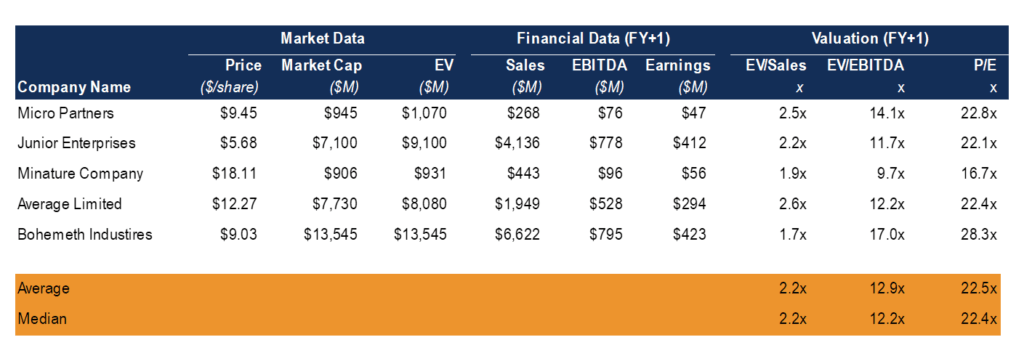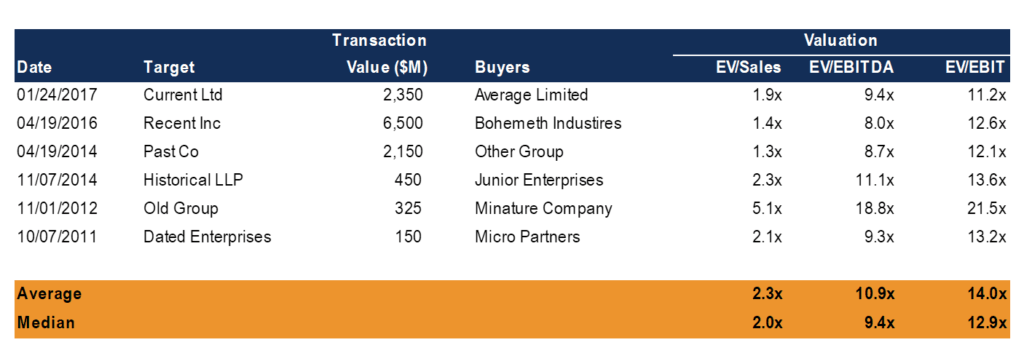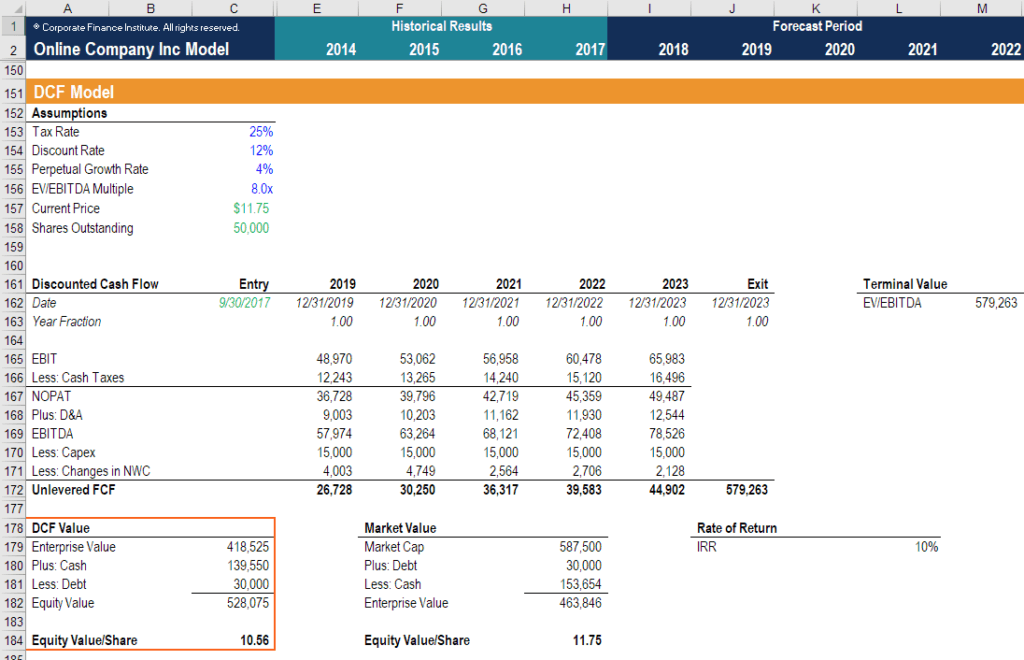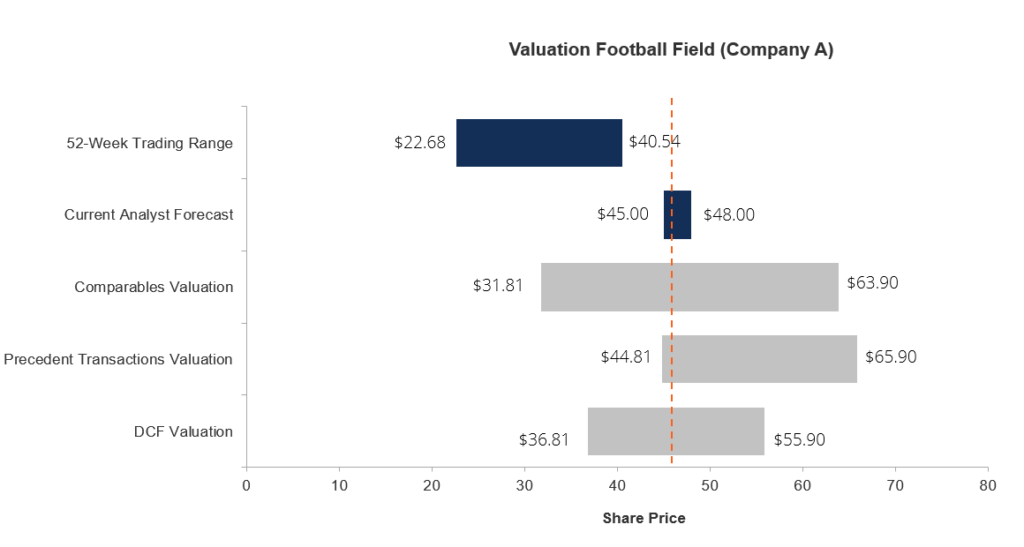The main methods used to value a business
What are the Main Valuation Methods?
When valuing a company as a going concern, there are three main valuation methods used by industry practitioners: (1) DCF analysis, (2) comparable company analysis, and (3) precedent transactions. These are the most common methods of valuation used in investment banking, equity research, private equity, corporate development, mergers & acquisitions (M&A), leveraged buyouts (LBO), and most areas of finance.

Image: CFI’s Business Valuation Course.
As shown in the diagram above, when valuing a business or asset, there are three different methods or approaches one can use. The Cost Approach looks at what it costs to rebuild or replace an asset. The cost approach method is useful in valuing real estate, such as commercial property, new construction, or special use properties. Finance professionals do not typically use it to value a company that is a going concern.
Next is the Market Approach, which is a form of relative valuation and is frequently used in the industry. It includes Comparable Analysis and Precedent Transactions.
Finally, the discounted cash flow (DCF) approach is a form of intrinsic valuation and is the most detailed and thorough approach to valuation modeling. We will describe the methods used in the Market and DCF approaches below.
Method 1: Comparable Analysis (“Comps”)
Comparable company analysis (also called “trading multiples” or “peer group analysis” or “equity comps” or “public market multiples”) is a relative valuation method in which you compare the current value of a business to other similar businesses by looking at trading multiples like P/E, EV/EBITDA, or other ratios. Multiples of EBITDA are the most common valuation method.
The “comps” valuation method provides an observable value for the business, based on what other comparable companies are currently worth. Comps are the most widely used approach, as they are easy to calculate and always current. The logic follows that if company X trades at a 10-times P/E ratio, and company Y has earnings of $2.50 per share, company Y’s stock must be worth $25.00 per share (assuming the companies have similar attributes).

Method 2: Precedent Transactions
Precedent transactions analysis is another form of relative valuation where you compare the company in question to other businesses that have recently been sold or acquired in the same industry. These transaction values include the take-over premium included in the price for which they were acquired.
The values represent the en bloc value of a business. They are useful for M&A transactions but can easily become stale-dated and no longer reflective of the current market as time passes. They are less commonly used than Comps or market trading multiples.

Method 3: DCF Analysis
Discounted Cash Flow (DCF) analysis is an intrinsic value approach where an analyst forecasts the business’ unlevered free cash flow into the future and discounts it back to today at the firm’s Weighted Average Cost of Capital (WACC).
A DCF analysis is performed by building a financial model in Excel and requires an extensive amount of detail and analysis. It is the most detailed of the three approaches and requires the most estimates and assumptions. However, the effort required for preparing a DCF model will also often result in the most accurate valuation. A DCF model allows the analyst to forecast value based on different scenarios and even perform a sensitivity analysis.
For larger businesses, the DCF value is commonly a sum-of-the-parts analysis, where different business units are modeled individually and added together. To learn more, see CFI’s DCF model infographic.

Image: CFI’s Business Valuation Course.
Football Field Chart (summary)
Investment bankers will often put together a football field chart to summarize the range of values for a business based on the different valuation methods used. Below is an example of a football field graph, which is typically included in an investment banking pitch book.
As you can see, the graph summarizes the company’s 52-week trading range (it’s stock price, assuming it’s public), the range of prices analysts have for the stock, the range of values from comparable valuation modeling, the range from precedent transaction analysis, and finally the DCF valuation method. The orange dotted line in the middle represents the average valuation from all the methods.

Image: Free Football Field Chart.
More Valuation Methods (Video)
The cost approach, which is not as commonly used in corporate finance, looks at what it actually costs or would cost to rebuild the business. This approach ignores any value creation or cash flow generation and only looks at things through the lens of “cost = value.”
Another valuation method for a company that is a going concern is called the ability to pay analysis. This approach looks at the maximum price an acquirer can pay for a business while still hitting some target. For example, if a private equity firm needs to hit a hurdle rate of 30%, what is the maximum price it can pay for the business?
If the company does not continue to operate, then a liquidation value will be estimated based on breaking up and selling the company’s assets. This value is usually very discounted as it assumes the assets will be sold as quickly as possible to any buyer.
Additional Valuation Resources
To learn more about how to value a business or to prepare for a career in corporate finance, we’ve got all the resources you need! Here are some of our most popular resources relate to valuation methods:

